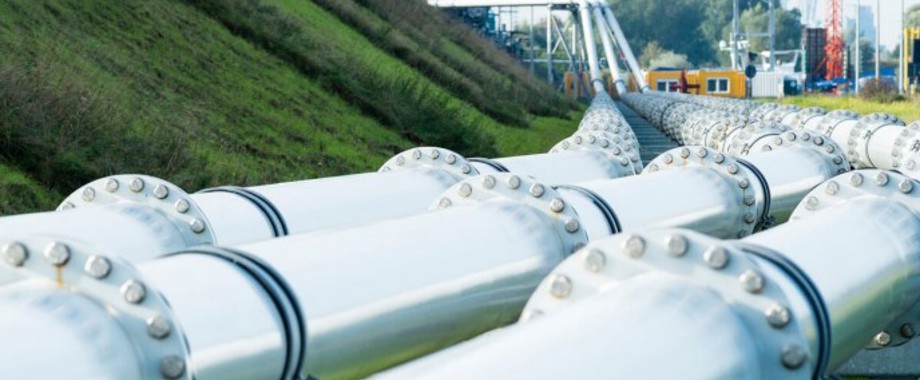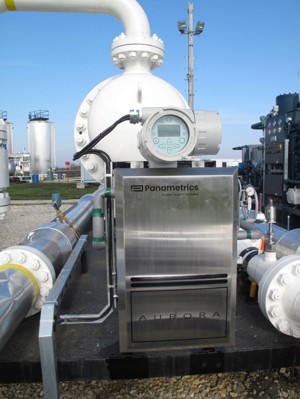
Accurate Moisture Measurement in Natural Gas Pipelines
Accurate moisture monitoring prevents hydrate formation, corrosion, and costly shutdowns. Panametrics analyzers ensure reliable gas quality and continuous protection across natural gas pipelines.
Natural gas is distributed through a network of pipelines and stored in tanks, underground caverns, and spent oil wells.
The presence of excess moisture in natural gas results in liquid water condensing or ice formation in cold climates or when gas is decompressed due to Joule-Thompson cooling. Excess moisture combined with high pressure leads to the formation of solid hydrates.
Ice and/or hydrate formation can restrict or even block the flow in the pipeline. In addition, the moisture content of the gas adversely affects the heating value (BTU) of the gas, thus lowering the quality and value of the product.
Water also combines with acid gases such as carbon dioxide and hydrogen sulfide and accelerates corrosion. To meet gas quality requirements and protect the pipeline and storage infrastructure, the moisture content must be continuously monitored.
Application
The distribution of natural gas must comply with specifications for the maximum moisture concentration, referred to as the tariff.
In the United States, the tariff is 7 lbs H₂O/MMSCF natural gas (pounds water per million standard cubic feet natural gas), and in Europe the maximum recommended level is –8°C dew point at 70 Bar(a).
Other countries and localities have similar specifications for the maximum amount of water in natural gas. Suppliers who exceed the maximum levels may be shut in for non-compliance — a shut-in is a direct loss of revenue for gas suppliers.
Challenge
Early detection of an increase in moisture content allows the operator to quickly respond to prevent catastrophic blockages, leaks due to corrosion, or loss of revenue due to a shut-in at a custody-transfer point.
Most gas distribution and compression facilities face challenges with fewer operation and maintenance personnel and higher reliance on automated data acquisition and control systems.
This means that instruments must be low-maintenance and reliable enough to operate unattended 24 hours a day. Today, Big Data collection is showing benefits by using intelligent processing to implement control, corrective action, and predictive maintenance.
Solutions
Installing Panametrics’ time-proven Aluminum Oxide trace moisture sensor offers great value. HygroPro transmitters offer a local display and a 4–20 mA signal for lbs/MMSCF, dew-point temperature, or ppmv (parts per million by volume).
For natural gas applications, the HygroPro is installed in a sample system designed to filter contaminants, regulate pressure, and indicate flow while giving the added option to control temperature.
The moisture.IQ is a multifunction and multichannel analyzer that connects to six AlOx trace moisture probes, six oxygen sensors, and 12 analog inputs. The analyzer is programmed via a color touchscreen or remotely via Ethernet (TCP/IP).
It provides digital and analog outputs and includes an internal data logger. The moisture.IQ has a built-in intrinsic safety scheme enabling connection to sensors in hazardous areas. These instruments are ideal for facilities with multiple measurement points or where redundant measurement is required. It is available in 19-inch rack-mount, wall-mounted weatherproof, and explosion-proof enclosures.
The PM880 is a portable, battery-operated, intrinsically safe analyzer ideal for spot checking and data logging. It can be used to verify moisture content at various locations in pipeline infrastructure.
The Aurora TDLAS (Tunable Diode Laser Absorption Spectrometer) moisture analyzer provides definitive moisture measurement using fully non-contact sensing technology.
The cost of installing an Aurora provides significant long-term savings because there is no need for field calibration or sending sensors out for recalibration. The Aurora uses the fastest-responding trace moisture measurement technology, quickly alerting to process upsets and confirming dry gas conditions.
The Aurora TransPort is a battery-operated portable analyzer assembled in a high-impact case, perfect for spot checking and where portable, fast-responding measurement is a priority.
Application Specifications
• USA: 0 – 25 lbs H₂O/MMSCF natural gas (0 – 525 ppmv) with alarm at 7 lbs
• Europe: –40 to 0 °C frost point at 70 Bar(a) with alarm at –8 °C frost point
• Options for display of moisture in lbs H₂O/MMSCF, dew-point temperature, or ppmv
• Analog outputs
• Local display
• Options for weather-proof and heated enclosures
• Options for sample conditioning systems
• Certification for hazardous-area operation: explosion-proof and intrinsically safe

